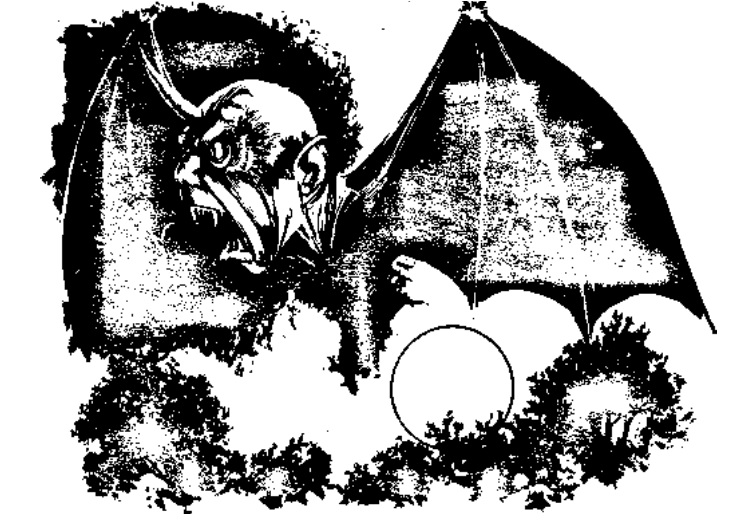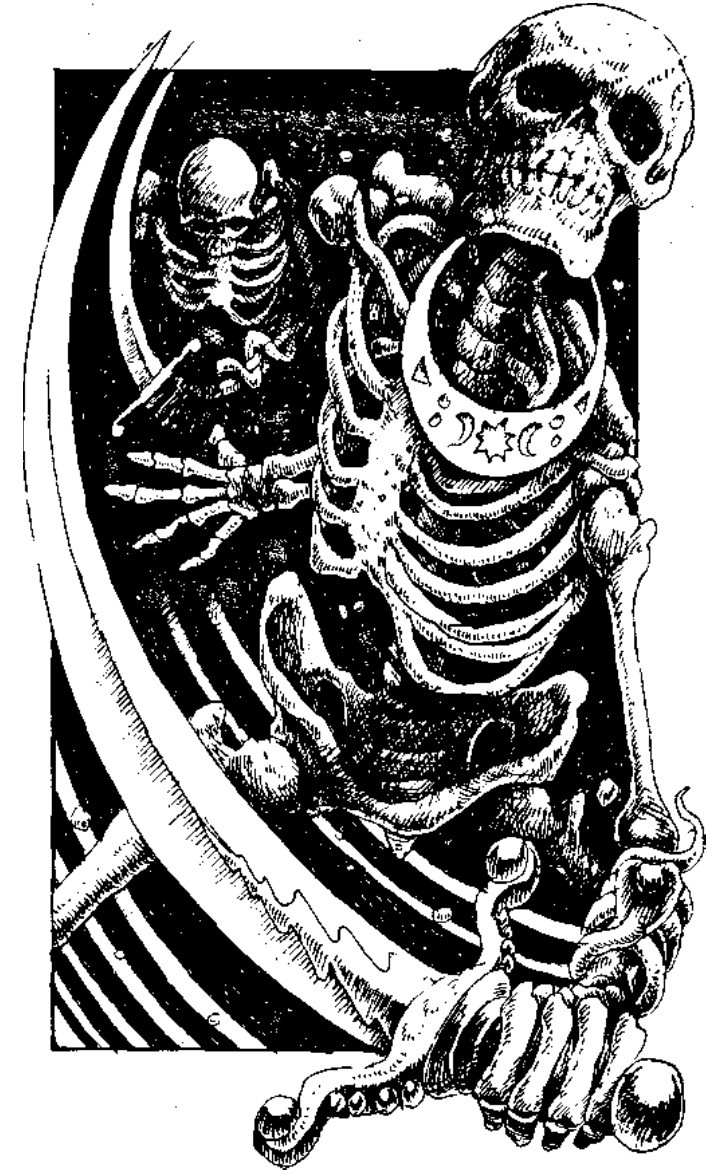Dave Morris wrote some of the game material that had the most impact on my impressionable young mind, and it appears that he might have a thing about flying heads, and that is maybe why I have a thing about flying heads.
So here's some flying heads, converted between systems.
Dragonwarriors to D&D: Chonchon, Death's Head, Obsidiak and Skullghast.
 |
Image: a flock of grotesque flying heads.
Leo Hartas, I think. |
See this post for an idea of how I arrive at the numbers below, and why there are choices.
Dragonwarriors doesn't give Intelligence for monsters, but the Chonchon and Death's Head are clearly intelligent on the same scale as Normal Humans, and can plan and communicate, the Skullghast is mindless and the Obsidiak is anyone's guess (at least animal intelligence, but probably alien).
Chonchon.
Ugly head with huge blue-veined ears it uses as wings; chisel-like teeth; said to be polymorphed and can't change back.
Out of the Shadows, p. 73-74
AC bonus +4* BAB +4 HD 2.8 (2+4/ 2+8/ 3) att. bite d8 (or d4)
- * AC +2 for DW Armour Factor, +2 for high DEFENCE
- flies as well as a Bat
- d6 + 3 Magic User levels (can use BAB, saves, and hit points if you prefer)
- invisibility to mortals of levels 1 to 4, until they attack or cast a spell, but only normal chances of surprise (they've got noisy 'wings'
- affected by holy symbols like a Vampire (as appropriate for your setting/system)
- there is a special spell (5th level caster to learn and use) to bring a chonchon down and render it helpless
- 'sly and cowardly': Morale 6
- bite has 25% of carrying a disease
- can see in the dark; dazzled by light
 |
Image: Horned, winged and fanged head flying on a moonlit night.
Bob Harvey. |
Head with bat wings and a horn - these vanish during the day; devours head from a body and reanimates it as a Zombie host to pretend to be a Normal Human.
Dragonwarriors, p. 80-81
AC bonus +7* BAB +5 HD 1.7 (1+4/ 1+7/ 2) att. horn d10 (or d8)
- * AC +3 for DW Armour Factor, +4 for very high DEFENCE
- flies as well as a Bat +50%
- spellbind, once per night, range 30', save vs. spells or stand in place while the Death's Head kills you (if you think this is too much, rule that a non-fatal attack ends the spell)
- Zombie host fights as appropriate for setting/system
- Zombie host 90% passable as human, but deteriorates 10% per day;
- 10% chance/ hit rolls of 19-20 strike the Death's Head, not the Zombie host
- Death's Head cannot detach from Zombie host until night falls; horn and wings immediately appear
- the host can be Turned; the Death's Head itself cannot - it is not undead
- can see in the dark
 |
Image: a crude human face with three tentacles.
The only pic of an Obsidiak I could find.
Don't know who it's by, and it's not how I imagine the monster. |
Obsidiak.
Bizarre dungeon monster; 'a slain Obsidiak will quickly decompose into a damp and evil-smelling ash.'
Dragonwarriors, p. 105-106
AC +3 BAB +3 HD 3.1 (3/ 3+1) att. bite d8 (or d6) or constrict
- flies half as well as a Bat (floating)
- 70% likely it bites in a combat round
- 30% it makes an attack vs. base AC & Dex mod to grasp & constrict
- target must make 3 Dex checks or arms are pinned and cannot fight back
- constrict damage die starts at d4 and advances each round (max. d20)
- constricting Obsidiak cannot do anything else, but misses against it hit the victim unless attacker makes a Dex check
- can see in the dark; dazzled by light
 |
Image: cover of Golden Dragon gamebook 'The Temple of Flame';
a parade of flame-wreathed skulls emerge from a stepped pyramid.
Bruno Elettori. |
Skullghast.
Dormant, they just look like old skulls, but burst into pale-gold flame and fly after you when activated.
Out of the Shadows, p. 132-133
AC +4* BAB +5 HD 0.6 (d4/ 1-1/ 1/ 3hp) att. flames d10 (or d6) + special
- *+4 for very high DEFENCE
- flies as well as a Bat +50%
- gaze attack: save vs. spells or weakened by fear (-3 STR & DEX for duration of encounter)
- damage from flames cannot be healed by magic below 3rd level
- spell-casters must save vs. spells per hit or lose one spell from memory, lowest level first
- 'fly in pursuit, even if the chase leads them out of the temple': Morale 12
- cannot be Turned (not true undead, by my reading of the text)
- can see in the dark
AD&D and D&D adjacent to Call of Cthulhu/BRP: Vargouille and Skullghast.
 |
Image: two monstrous winged heads.
DiTerlizzi (Planescape MC 1994) |
Vargouille, Shrieking Horrors.
Hideous fanged heads, maned with writhing tentacles, and carried aloft on a 3' span of bat-like wings. Otherwise voiceless, they give vent to bone-chilling shrieks as they surge up from the lightless gulfs they lair in.
Bright light, including the sun, blinds them, and they hate light, attempting to extinguish sources during an encounter. They are able to see (and track) the heat signature of living creatures in darkness, and may have an undocumented ultrasonic echo-location sense (explaining how they navigate caves and catacombs). Their eyes reflect green in low light.
Special abilities from 2nd edition AD&D also given as options, if you don't think they're Mythos enough as is.
STR 3d6 (av.10.5) CON 3d6 (av.10.5) SIZ 2d4 (av.5) INT 2d6 (av.7) POW 3d6 (av.10.5)
DEX 3d6 (av.10.5)
Hit Points 7-8 Damage Bonus nil Move 12 (flying)
Weapons:
- Bite 35%, 1-4 (d4)
- Bite damage is permanent and does not respond to natural healing, First Aid, or medical care; healing is only possible through magic or the ministrations of (say) Mi-Go, Eldritch Things, or time-travellers
- (2e) Shriek, POW vs. POW (or maybe a SAN test with no loss) or victim is paralysed with fright until the Vargouille has taken a free attack
- (2e) Kiss, POW vs. POW or begin transforming into a Vargouille:
- only on paralysed victims
- +d6 hours, all hair on head falls out
- +d6 hours, pointed ears and fangs, tentacles sprout from head and chin; lose d6 INT & 2d6 APP
- +d6 hours, body dies - the new Vargouille will unfurl its wings and detach next time it is in darkness
- very bright light halts the process, but cannot end or reverse it
Armour: 2 points of rubbery hide
Skills: Dodge DEX x4; Track by Heat 60%
Sanity Loss: 0/d6 to see a Vargouille; same again at each stage of transformation if subject to the Kiss, or to see another transformed.
Skullghast, Eerie Temple Guardians.
For when you need a rest from tentacles and something a little bit Indiana Jones to relax.
Wreathed in cold, otherworldly flames and utterly silent, these are earthly nightmares but nightmares nonetheless. Enchanted by sorcerers living or long dead, they are set as guards. They will pursue intruders to a distance designated during their creation, but will always return to their original resting places.
They render victims helpless, who are then prey to other denizens of the location (usually a tomb or temple), or to dehydration and exposure, as the Skullghasts will swoop every time a helpless victim recovers enough to try and escape.
Converted using the D&D adjacent stats above, some Mythos licence, and referencing the CoC Skeleton.
STR 2d6 (av. 7) CON n/a SIZ d4 (av. 2-3) INT n/a POW 1 DEX 2d6+6 (av. 13)
Hit Points n/a Damage bonus nil Move 12 (flying)
Weapons:
- Touch, 50% (or DEX x 3 - your choice), 1 STR, 1 DEX and 1 magic point
- lost characteristic points recover at the same rate as magic points
Armour: none, but only harmed if destroyed (% chance = damage scored x4; x2 for impaling weapons, including firearms)
Skills: Dodge (DEX x 4); Relentless Pursuit 60%
Sanity loss: 0/d6 to see a Skullghast; 1/1d6+1 to spend any significant time helpless in a Skullghast lair, without apparent hope of escape or rescue, slipping in and out of unconsciousness at the unearthly touch of the pale-gold flame, as the rats and beetles crawl across your shivering body.
Monster Ratings for Tunnels & Trolls 5e, too.
- Chonchon: MR 28; on doubles casts a spell of level 1-6.
- Death's Head: MR 17; spellbind, 2nd level IQ save to resist; 2nd level DEX save to hit in flight; one or more Zombies nearby.
- Obsidiak: MR 31; on doubles constricts you for unopposed damage (armour counts for 1st round only), cumulatively more difficult STR save to escape each round and you can't do anything else.
- Skullghast: MR 6; damage comes off STR, too (or whatever wizards use in later editions); 2nd level DEX save to hit in flight; come in flocks of 2-12, even on the first dungeon level.
- Vargouille: MR 21; on doubles 1 point of your CON never comes back, except by gaining a level.
Increase the MR the deeper into the tunnels you delve. Obviously.












